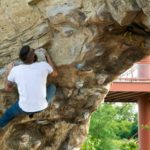Climbing, whether it is at an indoor rock gym or on real rock faces outdoors, requires you to fire up a lot of different muscles from your forearm to your feet. Even though rock climbing is considered a technical and mental sport, it requires massive physical strength to balance, traverse, and make explosive movements up a rock face.
Climbers require endurance to sustain longer climbs and a remarkable core strength to climb against gravity. However, considering that your fingers are your only link to the rock, nobody can argue that, as a rock climber, the most essential strength for you is finger and wrist strength. Hence, increasing your peak finger force is central to upping your rock climbing game. Most climbing experts believe that you cannot move past it if you cannot hang onto something.
While diving into climbing is the best way to develop the required skill set, it is not ideal for developing grip strength. The most effective way to train and develop handgrip strength, endurance, and finger strength is by hangboard training, a.k.a. fingerboard training.
Hangboards, usually made of resin or wood, imitate various holds and grips that allow the climber to isolate the fingers and train them specifically, developing strength for climbing.
What is a hangboard?
Hangboards, also called climbing fingerboards, are training boards specifically designed to help climbers raise their strength ceiling. As mentioned, they are either constructed using wood or resin and have a variety of notches that imitate different holds and grip positions that climbers may come across on rock faces. It helps climbers in isolating their fingers to train them and to improve the overall finger strength.
The first hangboard was designed in the 1980s, and since its inception, it has become the most used training equipment amongst avid climbers. Mainly because of its ease of access and its ability to isolate various grip positions precisely. The best part is that they are economical and can be easily mounted on in any apartment or home.
Importance of hangboarding
Irrespective of your preferred style and technique of climbing, finger, and wrist strength is something that will become central to your improvement and advancement. There may come a time in your climbing when your lack of finger strength and inability to grip small edges becomes a barrier.
Hangboarding, if done correctly, can bump up your strength ceiling by folds. We often see rock climbers reach a plateau at a certain level; hangboarding can help them work through it. Although the whole process is not designed to improve your climbing, it gives you an edge with the right technique and skill.
If you cannot (or don’t want to) join a climbing gym, hangboard training is one of the most time-efficient methods to build hand and finger strength. Usually, experts recommend around two or three 30-minute workouts in a week for beginner and intermediate climbers.
When to hangboard?
Even though a hangboard is an excellent piece of equipment to train your fingers and wrists, it is not appropriate for immediate beginners. Amateur climbers are usually advised to increase their strength to weight ratio by reducing unwanted muscle and excessive fat, within reason, of course.
Most climbing experts believe that climbers should wait at least six months before they start adding hangboarding to their exercise routine. In the beginning, trying out every exercise to help boost your climbing experience is quite tempting. However, if you try and use the hangboard before the said period, it will be counterproductive. Starting hangboard training before you are ready can lead to severe injuries, including sprains, fractures, and torn tendons.
Strength gains are not realized overnight. It takes months, even years, to reach the gains required to become a pro rock climber. Hence, it is imperative that you give your body the time and nutrition to adjust and build up muscles.
**Note that individuals under eighteen years of age should not consider hangboarding as it can cause permanent damage to finger joints and bones.
However, if you are an intermediate level climber and want to experience a multi-grade boost in your climbing, it is time for you to start hangboard training. According to recent research by the United States Air Force Academy Department of Engineering Mechanics, 86 out of 100 participants reported improved climbing performance after hangboard training.
Finding the right hangboard
If you are just starting your hangboard training, finding the best hangboard might be more challenging than you expected. There more than a few different types of hangboards available on the market. However, as someone who has no experience with the equipment, you should look for a hangboard that is easy on the hands and gives you enough freedom to improve your grip strength before moving on to developing finger strength.
You might want to look for a hangboard with a plastic grip similar to gym holds that most beginners use. Preferably, it should have a range of different holds with progression to smaller sizes. If you don’t have a dedicated area for hangboarding in your house/apartment yet, look for a portable hangboard that can be tucked away in the storage after the training session.
Conclusion
Hangboarding is painful and challenging. Most of the time, it will suck, and you will be bored. Despite this, it is something that will give your rock climbing a boost in the right direction. Where the training does not directly affect and improve your climbing ability, it helps you in gaining the strength you need along with the climbing techniques you already know.
Hangboard training is also vital for preventing cramping and injury to your wrist or finger joints while climbing. If done systematically, the training process will get your fingers stronger and will help in developing calluses. Moreover, your tolerance for pain while climbing will increase by folds making grabbing small crimps easy.
That said, if you don’t know where to start your training, it is advised that you look for a tried and tested training plan on the internet or talk to your trainer. Don’t jump into hangboard training on your own, as you might end up injuring one of your fingers or your wrist.







